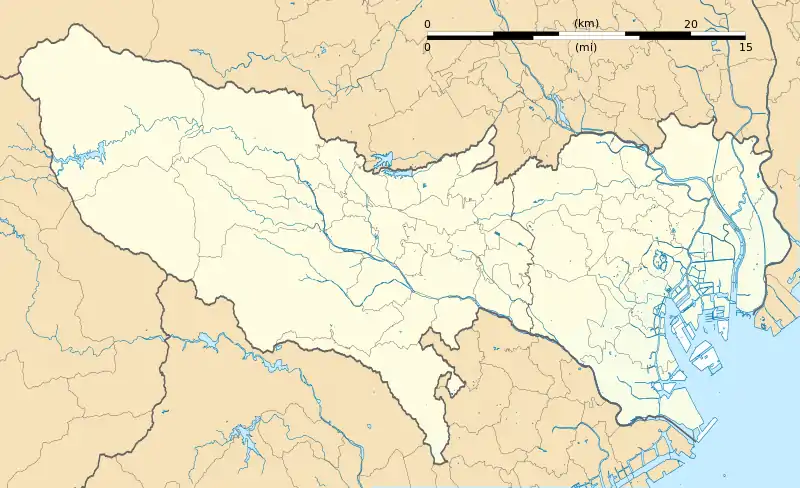Daimon Station (Tokyo)
Daimon Station (大門駅, Daimon-eki) is a subway station in Minato, Tokyo, Japan, operated by the Tokyo subway operator Toei Subway. The station is named after the Shiba Daimon or Great Gate of Shiba, located just west of the station on the road leading to the temple of Zōjō-ji.
A09 E20 Daimon Station 大門駅 | |||||||||||||||||||
|---|---|---|---|---|---|---|---|---|---|---|---|---|---|---|---|---|---|---|---|
 Asakusa Line ticket gates, 2018 | |||||||||||||||||||
| Location | 1-27-12 (Asakusa Line) 2-3-4 (Oedo Line) Hamamatsuchō, Minato-ku, Tokyo Japan | ||||||||||||||||||
| Operated by | |||||||||||||||||||
| Line(s) | |||||||||||||||||||
| Other information | |||||||||||||||||||
| Station code |
| ||||||||||||||||||
| History | |||||||||||||||||||
| Opened | 1 October 1964 | ||||||||||||||||||
| Services | |||||||||||||||||||
| |||||||||||||||||||
| Location | |||||||||||||||||||
 Daimon Station Location within Special wards of Tokyo  Daimon Station Daimon Station (Tokyo)  Daimon Station Daimon Station (Japan) | |||||||||||||||||||
Daimon is adjacent to Hamamatsuchō Station, which is served by JR East and the Tokyo Monorail. On the Toei lines, Daimon is called "Daimon Hamamatsucho" in certain automated announcements. The Oedo Line station, which occupies most of the space between the Asakusa Line and the JR lines, was initially planned to be called "Hamamatsucho", but ultimately adopted the name of the existing Asakusa Line station.
Lines
- Toei Asakusa Line (Station A-09)
- Toei Oedo Line (Station E-20)
Station layout
The Asakusa Line station has two side platforms. The Oedo Line station has one island platform.
Platforms
| 1 | A Toei Asakusa Line | for Sengakuji and Nishi-magome KK Keikyu Main Line for Shinagawa, Haneda Airport (International Terminal and Domestic Termimal) and Misakiguchi |
| 2 | A Toei Asakusa Line | for Nihombashi and Oshiage KS Keisei Main Line for Keisei-Takasago, Keisei-Tsudanuma and Narita Airport (Terminal 2·3 and Terminal 1) HS Hokuso Line for Imba Nihon-idai KS Narita Sky Access Line for Narita Airport SR Shibayama Railway Line for Shibayama-Chiyoda |
| 3 | E Toei Oedo Line | for Ryogoku and Iidabashi |
| 4 | E Toei Oedo Line | for Roppongi, Tochomae, and Hikarigaoka |
 Asakusa Line platform, 2020
Asakusa Line platform, 2020 Oedo Line platforms, May 2018
Oedo Line platforms, May 2018
History
- October 1, 1964: Opened as a station on Toei Subway Line No. 1 (Asakusa Line).
- December 12, 2000: Oedo Line service begins.
Passenger statistics
The Asakusa Line station was used by an average of around 91,000 arriving and departing passengers per day,[1] while the Oedo Line station was used by an average of around 114,000.[2]
References
- "各駅情報". Bureau of Transportation, Tokyo Metropolitan Government. Archived from the original on 19 December 2013. Retrieved 19 December 2013.
- "各駅情報". Bureau of Transportation, Tokyo Metropolitan Government. Archived from the original on 19 December 2013. Retrieved 19 December 2013.
| Wikimedia Commons has media related to Daimon Station (Tokyo). |